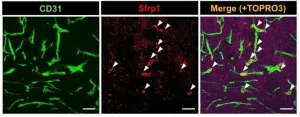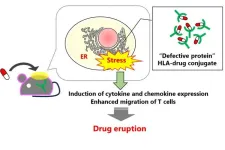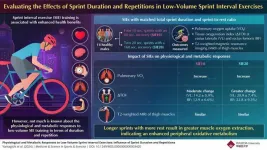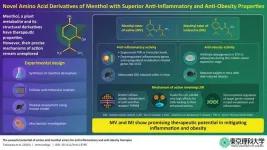(Press-News.org) DALLAS, May 15, 2024 — Despite strides in cardiopulmonary resuscitation (CPR) training, consumer research from the American Heart Association reveals only 1 in 4 Asian American individuals are confident they could correctly perform Hands-Only CPR, compared with a comparable confidence rate of more 1/3 of the general population. The same survey showed nearly 70% of Asian American adults are hesitant to perform Hands-Only CPR because they are worried they will hurt the person who has suffered a cardiac arrest. Among the general population, 57% still express this fear. To build CPR skills, knowledge, and confidence and close these gaps, the American Heart Association, the leading global voluntary health organization focused on heart and brain health and celebrating 100 years of lifesaving service, is launching the “Today You Were Ready” nationwide awareness campaign aimed at empowering Asian American communities to learn Hands-Only CPR and be ready to save a life.
The campaign launch coincides with Asian American Native Hawaiian Pacific Islander Heritage (AANHP) Month and includes community outreach to emphasize the importance of being prepared to respond to a cardiac emergency. The effort is part of the overarching American Heart Association's Nation of LifesaversTM movement, which is focused on turning bystanders into lifesavers and doubling survival rates from sudden cardiac arrest by 2030.
“Unless we share these critical public health messages, Asian American Pacific Islander communities and other historically excluded groups will remain more likely to die of sudden cardiac arrest than other groups,” said Joseph C. Wu, M.D., Ph.D., FAHA, current volunteer president of the American Heart Association, director of the Stanford Cardiovascular Institute and the Simon H. Stertzer Professor of Medicine and Radiology at Stanford School of Medicine. “The ’Today You Were Ready’ campaign will address those barriers and will provide these communities with the tools and resources they need to learn and perform Hands-Only CPR.”
Cardiac arrest can happen to anyone at any time, and without quick bystander CPR, it is typically fatal. According to research in the Journal of the American Heart Association, about 72% of cardiac arrests that occur outside of a hospital happen at home. That means that if you are called on to perform CPR, it will likely be to save the life of someone you love. Cardiopulmonary resuscitation is an emergency response that can help save a person’s life if their breathing or heart stops. At the forefront of resuscitation science, education, and training, the American Heart Association is the worldwide leader and publisher of the official scientific guidelines for CPR.
By showcasing the two easy steps to help save a life, the Association aims to change and break through the hesitancy barrier. Hands-Only CPR is CPR without breaths. It is for teens and adults only and is performed in two steps: 1) Call 911 and 2) push hard and fast in the center of the chest to a beat of 100- 120 beats per minute.
When it comes specifically for women, studies show that women who have a cardiac arrest outside a hospital setting are less likely than men to receive lifesaving CPR.[1] This gap is even larger for Asian American and Pacific Islander women.[2] According to data from the American Heart Association, these women are less likely to receive bystander CPR compared to other populations, contributing to lower survival rates. Cultural factors, language barriers and limited access to CPR education may further exacerbate these disparities. The fear of accusations of inappropriate touching or injuring the person and lack of knowledge about their state’s Good Samaritan Laws contribute to some people’s hesitance to perform CPR.[3] [4] Improving CPR awareness and accessibility within the Asian American Pacific Islander community is crucial to increasing survival rates for women experiencing cardiac emergencies.
“By inspiring our Asian American Pacific Islander community to learn Hands-Only CPR, we can improve health outcomes for Asian American women and their loved ones, especially those suffering cardiac arrest,” said Wu.
In the United States, the Asian American Pacific Islander communities and other people of underrepresented populations are at a higher risk of poor outcomes from out-of-hospital cardiac arrest than the general population, in part due to longstanding structural racism and social policies that have limited access to quality education and health care.[5][6]
Survey findings from the Association show that historically excluded populations are more likely to incorrectly believe that special training and certification are required to perform Hands-Only CPR on an adult or teen and more likely to be hesitant to perform the skill for fear of causing injury.[7] These misperceptions contribute to poor survival rates (less than 10%) from out-of-hospital cardiac arrest, which affects more than 350,000 Americans annually.[8]
To learn more about the campaign or to get involved, visit heart.org/nation.
Additional Resources:
Multimedia is available on the right column of the release link.
Release in Tagalog, Chinese Simplified and Chinese Traditional (docs)
Understanding the Importance of the Lay Responder Experience in Out-of-Hospital Cardiac Arrest: A Scientific Statement From the American Heart Association Difference in Cardiac Arrest vs. Heart Attack
Learn Hands-Only CPR/use an AED (Video) (English, Spanish, Mandarin)
AHA health information: Bystander CPR
AHA health information: Hands-Only CPR Resources
Follow AHA/ASA news on X (formerly known as Twitter) @HeartNews
# # #
About the American Heart Association
The American Heart Association is a relentless force for a world of longer, healthier lives. We are dedicated to ensuring equitable health in all communities. Through collaboration with numerous organizations, and powered by millions of volunteers, we fund innovative research, advocate for the public’s health and share lifesaving resources. The Dallas-based organization has been a leading source of health information for a century. During 2024 - our Centennial year - we celebrate our rich 100-year history and accomplishments. As we forge ahead into our second century of bold discovery and impact our vision is to advance health and hope for everyone, everywhere. Connect with us on heart.org, Facebook, X or by calling 1-800-AHA-USA1.
[1] Three Things You May Not Know About CPR | cdc.gov
[2] Women have lower chances than men to be resuscitated and survive out-of-hospital cardiac arrest - PMC (nih.gov)
[3] Cardiovascular Disease in Hispanics/Latinos in the United States - PMC (nih.gov)
[4] Legal risk of not performing CPR higher than providing lifesaving assistance | American Heart Association
[5] Part 1: Executive Summary: 2020 American Heart Association Guidelines for Cardiopulmonary Resuscitation and Emergency Cardiovascular Care | Circulation (ahajournals.org)
[6] Bystander CPR less common in Hispanic neighborhoods | American Heart Association (Blewer, et al. Circulation. 2020;141:34–41)
[7] Social Determinants of Cardiovascular Risk Factors Among Asian American Subgroups | Journal of the American Heart Association (ahajournals.org)
[8] Heart Disease and Stroke Statistics—2022 Update: A Report From the American Heart Association | Circulation (ahajournals.org)
[9] American Heart Association Heart and Stroke Stat update 2023 (Tsao et al, Circulation. 2023;147: e93–e621) Please update to 2024 heart disease and Stroke Stats reference
END
New campaign aims to empower Asian American communities with lifesaving CPR skills
‘'Today You Were Ready” initiative to close the confidence gap and improve cardiac arrest survival rates among Asian Americans
2024-05-15
ELSE PRESS RELEASES FROM THIS DATE:
Repurposed beer yeast may offer a cost-effective way to remove lead from water
2024-05-15
CAMBRIDGE, MA – Every year, beer breweries generate and discard thousands of tons of surplus yeast. Researchers from MIT and Georgia Tech have now come up with a way to repurpose that yeast to absorb lead from contaminated water.
Through a process called biosorption, yeast can quickly absorb even trace amounts of lead and other heavy metals from water. The researchers showed that they could package the yeast inside hydrogel capsules to create a filter that removes lead from water. Because the yeast cells are encapsulated, they can be easily removed from the water once it’s ready ...
NFCR CEO Dr. Sujuan Ba honored at AAPI Women's Gala 2024
2024-05-15
The National Foundation for Cancer Research proudly announces that our CEO, Dr. Sujuan Ba, was honored as one of the AAPI Women Leaders at the AAPI Women's Gala 2024 on May 14th in New York City. This prestigious event was hosted by The Serica Initiative to spotlight the outstanding achievements and contributions of Asian American and Pacific Islander (AAPI) women who are breaking barriers and making impacts in many sectors, enriching and adding value to our society.
This 8th year's gala, themed "Resilience and Perseverance," honored Dr. Ba for her exemplary leadership at NFCR and other organizations she is part of and her ...
Climate change is most prominent threat to pollinators, CABI Reviews paper finds
2024-05-15
A paper published in the CABI Reviews journal has found that climate change is the most prominent threat to pollinators – such as bumblebees, wasps, and butterflies – who are essential for biodiversity conservation, crop yields and food security.
The research, which is entitled ‘What are the main reasons for the world-wide decline in pollinator populations?’, suggests that many of the threats to pollinators result from human activities.
Pollinator populations are declining worldwide and 85% of flowering plant species and 87 of the leading global crops rely on pollinators for seed production. The decline of ...
New study links protein secreted by blood vessels to drug-resistant cancer
2024-05-15
Cancer is a leading cause of death globally. One of the primary reasons why cancer is such a deadly disease is the ability of cancer cells to become drug-resistant. After decades of medical research, scientists came to understand that malignant tumors often harbor a special population of cells called cancer stem cells (CSCs). Much like normal stem cells, CSCs can self-renew and differentiate into various cell types within a tumor, playing important roles not only in tumor growth and metastasis but also in the development of drug resistance.
Unfortunately, developing therapies targeting CSCs directly ...
Exploring the mechanism behind drug eruptions in the skin
2024-05-15
Although medications can often help patients find a cure or respite from their condition, millions of people worldwide suffer from unpredictable drug toxicities every year. In particular, drug eruptions which manifest through symptoms such as redness, blisters, and itching on the skin, are quite common. Severe drug eruptions can become life-threatening and can have long-lasting consequences. Thus, understanding how and why drug eruptions occur is an important area of research in medical science.
To this end, previous studies have identified specific variants of certain genes as potential causal agents of drug eruptions. Scientists believe that ...
Longer sprint intervals can improve muscle oxygen utilization compared to shorter intervals
2024-05-15
Physical activities like jogging, walking, cycling, and sprinting are activities known to engage the musculoskeletal system and result in the utilization of energy. Sprint interval training (SIT) is a type of sprinting exercise that involves cycles of intense exercise followed by a short duration of rest. How the durations of exercise and rest are structured can affect the impact of SIT on physiological responses. In recent years, the field of sports physiology has witnessed increased interest in optimizing SIT protocols. This surge can enhance the recognition of SIT’s efficacy in improving athletic performance and overall well-being, highlighting its versatility as a tool ...
Fighting fat and inflammation: Scientists develop powerful new compounds
2024-05-15
Modified derivatives of natural products have led to significant therapeutic advances and commercial success in recent times. Menthol is a naturally occurring cyclic monoterpene alcohol found in various plants, particularly in members of the mint family such as peppermint and spearmint. It is a common ingredient found in a wide range of confectionaries, chewing gums and oral care products. Interestingly, menthol also has high medicinal value due to its analgesic, anti-inflammatory, and anti-cancer effects.
In a recent study, a team of researchers led by Professor Gen-ichiro Arimura ...
New cardiac research will save women’s lives by improving detection of heart failure
2024-05-15
Peer-reviewed – Observational Study - People
An important new study has advanced how heart failure is detected in women – meaning more female patients can be diagnosed and at an earlier stage.
Researchers led by teams from the Universities of East Anglia (UEA), Sheffield and Leeds, have been able to fine-tune how magnetic resonance imaging (MRI) is used to detect heart failure in women’s hearts, making it more accurate.
Lead author Dr Pankaj Garg, of the University of East Anglia’s Norwich Medical School and a consultant cardiologist at the Norfolk and Norwich University Hospital, said: “By refining the method for women ...
Polyglycerol coating: A breakthrough in safer nanoparticle environmental remediation
2024-05-15
Nanoparticles (NPs) are often used to reduce environmental pollution by targeting harmful chemicals in soil and water that are released by industrial and agricultural activities. These NPs are engineered to absorb, degrade, or neutralize these pollutants, providing a potential solution to environmental contamination. However, when released into the environment, they can be consumed by organisms and transferred through the food chain, resulting in widespread toxicity.
To address this issue, a research ...
Circe Bioscience licenses technology to decarbonize industry with microbes developed at Wyss Institute at Harvard University
2024-05-15
The Wyss Institute for Biologically Inspired Engineering at Harvard University announced today that Circe, a startup developed at the Institute and spun out of Harvard, has signed a worldwide, exclusive licensing agreement coordinated by Harvard’s Office of Technology Development (OTD) to commercialize a novel bioproduction technology that could significantly reduce the carbon emissions of industries from food to aviation fuel.
Circe has raised more than $8 million to date from investors including Regen Ventures, Undeterred Capital, Ponderosa Ventures, Bee Partners, and Elementum Ventures.
“One of the great challenges ...
LAST 30 PRESS RELEASES:
Ocean temperatures reached another record high in 2025
Dynamically reconfigurable topological routing in nonlinear photonic systems
Crystallographic engineering enables fast low‑temperature ion transport of TiNb2O7 for cold‑region lithium‑ion batteries
Ultrafast sulfur redox dynamics enabled by a PPy@N‑TiO2 Z‑scheme heterojunction photoelectrode for photo‑assisted lithium–sulfur batteries
Optimized biochar use could cut China’s cropland nitrous oxide emissions by up to half
Neural progesterone receptors link ovulation and sexual receptivity in medaka
A new Japanese study investigates how tariff policies influence long-run economic growth
Mental trauma succeeds 1 in 7 dog related injuries, claims data suggest
Breastfeeding may lower mums’ later life depression/anxiety risks for up to 10 years after pregnancy
Study finds more than a quarter of adults worldwide could benefit from GLP-1 medications for weight loss
Hobbies don’t just improve personal lives, they can boost workplace creativity too
Study shows federal safety metric inappropriately penalizes hospitals for lifesaving stroke procedures
Improving sleep isn’t enough: researchers highlight daytime function as key to assessing insomnia treatments
Rice Brain Institute awards first seed grants to jump-start collaborative brain health research
Personalizing cancer treatments significantly improve outcome success
UW researchers analyzed which anthologized writers and books get checked out the most from Seattle Public Library
Study finds food waste compost less effective than potting mix alone
UCLA receives $7.3 million for wide-ranging cannabis research
Why this little-known birth control option deserves more attention
Johns Hopkins-led team creates first map of nerve circuitry in bone, identifies key signals for bone repair
UC Irvine astronomers spot largest known stream of super-heated gas in the universe
Research shows how immune system reacts to pig kidney transplants in living patients
Dark stars could help solve three pressing puzzles of the high-redshift universe
Manganese gets its moment as a potential fuel cell catalyst
“Gifted word learner” dogs can pick up new words by overhearing their owners’ talk
More data, more sharing can help avoid misinterpreting “smoking gun” signals in topological physics
An illegal fentanyl supply shock may have contributed to a dramatic decline in deaths
Some dogs can learn new words by eavesdropping on their owners
Scientists trace facial gestures back to their source. before a smile appears, the brain has already decided
Is “Smoking Gun” evidence enough to prove scientific discovery?
[Press-News.org] New campaign aims to empower Asian American communities with lifesaving CPR skills‘'Today You Were Ready” initiative to close the confidence gap and improve cardiac arrest survival rates among Asian Americans





